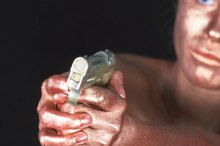How to Tell If a Person Is Using Cocaine
According to The National Institute on Drug Abuse, six million Americans 12 years old and older tried cocaine in 2006 and 1.5 million had used crack cocaine at least once in the past year 12. One of the most addictive drugs, cocaine gives users a euphoric feeling and makes them more energetic. Besides the impact to their families and employment, cocaine users risk heart attacks, strokes, seizures and respiratory failure. In isolated cases, sudden death has been attributed to cocaine use. Cocaine may be snorted, inhaled or injected, with each method of administration producing a different duration and intensity of effect.
Look for physical changes if you think someone you know is using cocaine. The Cocaine Drug Addiction website states that cocaine users often have bloodshot eyes, dilated pupils, nose bleeds, nasal problems, insomnia, or a rapid or irregular heartbeat 2.
How to Help Your Cocaine-Addicted Friend
Learn More
Consider whether the person has been having personality changes, such as irritability, anxiety attacks or frequent moods swings. The Drug Independence website states that this can be a sign that he is “coming down” from a cocaine binge, or feeling the need to find and use drugs 23. Additionally, a cocaine user may exhibit dishonest behavior, such as stealing from family and friends. Paranoia can also be a sign of cocaine abuse, and the user may compulsively feel that people are after her or staring at her. Someone who naturally is even-tempered may become quick to anger as a side effect of cocaine use.
Watch for reoccurring family issues, such as the suspected user staying out later than usual or locking himself in his bedroom. Household bills may go unpaid for unsatisfactory reasons, and unexplained debt may pile up as savings are depleted. Relationship problems are common, as the cocaine user often alienates herself from her support group while cultivating a new group of drug-using friends 2.
Negative Effects From Drug Abuse
Learn More
Investigate whether the person is having problems at work. Poor job performance can be a sign of cocaine use. Conversely a person using cocaine may work extra long hours as the drug gives him a feeling of energy 2. Frequent absences or tardiness that has no legitimate excuse may be due to cocaine use, as can an unexplained job loss.
Tips
If you believe a friend or family member is using cocaine, it’s a good idea to contact a professional to learn how to cope with and help the drug user overcome their addiction.
Related Articles
References
- The National Institute on Drug Abuse
- Drug Independence
- National Institute on Drug Abuse. What is cocaine?. Updated July 2018.
- Favrod-Coune T, Broers B. The Health Effect of Psychostimulants: A Literature Review. Pharmaceuticals (Basel). 2010;3(7):2333-2361. doi:10.3390/ph3072333
- Havakuk O, Rezkalla SH, Kloner RA. The Cardiovascular Effects of Cocaine. J Am Coll Cardiol. 2017;70(1):101-113. doi:10.1016/j.jacc.2017.05.014
- National Institute on Drug Abuse. Cocaine. Research Report Series. Why are cocaine users at risk for contracting HIV/AIDS and hepatitis? Updated May 2016.
- Middleton RM, Kirkpatrick MB. Clinical Use of Cocaine. Drug-Safety. 1993;9:212-217. doi:10.2165/00002018-199309030-00006
- Morton WA. Cocaine and Psychiatric Symptoms. Prim Care Companion J Clin Psychiatry. 1999;1(4):109-113. doi:10.4088/pcc.v01n0403
- National Institute on Drug Abuse. Cocaine. 2020.
- Tang YL, Kranzler HR, Gelernter J, Farrer LA, Pearson D, Cubells JF. Transient cocaine-associated behavioral symptoms rated with a new instrument, the scale for assessment of positive symptoms for cocaine-induced psychosis (SAPS-CIP). Am J Addict. 2009;18(5):339-345. doi:10.3109/10550490903077937
- Substance Abuse and Mental Health Services Administration. National Survey on Drug Use and Health. Key Substance Use and Mental Health Indicators in the United States: Results from the 2017 National Survey on Drug Use and Health. 2018.
- Wong GTC, Irwin MG. Poisoning with illicit substances: toxicology for the anaesthetist. Anaesthesia. 2013;68:117-124. doi:10.1111/anae.12053
- Hadland SE, Levy S. Objective Testing: Urine and Other Drug Tests. Child Adolesc Psychiatr Clin N Am. 2016;25(3):549-565. doi:10.1016/j.chc.2016.02.005
- Sinha R. The clinical neurobiology of drug craving. Curr Opin Neurobiol. 2013;23(4):649-654. doi:10.1016/j.conb.2013.05.001
- Liu Y, Ball JD, Elliott AL, Jacobs-Elliott M, Nicolette G. Diagnostic sequence of cocaine use disorder in relation to other mental health conditions among college students. J Am Coll Health. 2019:1-4. doi:10.1080/07448481.2019.1583657
- Kampman KM. The treatment of cocaine use disorder. Science Adv. 2019;5(10). doi:10.1126/sciadv.aax1532
- American Society of Addiction Medicine. The Definition of Addiction (Long Version). 15 August 2011.
Writer Bio
Robin Hewitt began her writing career in 2008. She is the coauthor of several books, including "The Joyous Gift of Grandparenting," which covers the nutritional and fitness needs of both grandchildren and grandparents.









